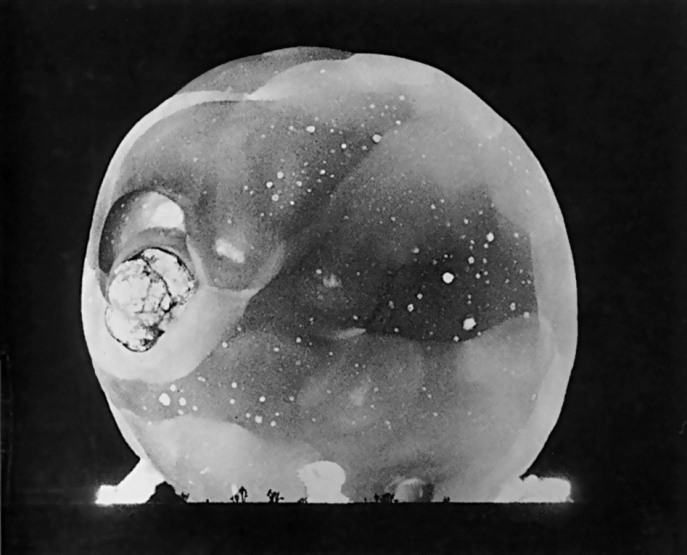For the early nuclear weapons scientists, being able to observe the rapidly changing matter in nuclear explosions was vital to their understanding of the phenomena and the effects. Several aspects of the blast (e.g. the blinding light, the speed of the nuclear reaction in the bomb, and the need to be miles away from the detonation) made it very difficult to capture the initial stages on film.
In 1947 the Atomic Energy Commission contracted innovative photographic engineer Harold ‘Doc’ Edgerton and two colleagues, Kenneth Germeshausen and Herbert Grier – their mission, improve imaging results.
By 1950 EG&G, Inc. had invented a device capable of capturing images from the fleeting instant directly following a nuclear explosion. Enter the rapatronic (for Rapid Action Electronic) shutter – a shutter with no moving parts that could be opened and closed by turning a magnetic field on and off.
The single-use rapatronic cameras were able to snap a photo one millisecond after detonation – at times even less – from about seven miles away. The duration of the exposure was as little as two microseconds.
The resulting images were eerie and fascinating.

This is an image of a ‘shot cab’ – the housing at the top of the tower that contains the explosive device. (Photo via Edgerton Digital Collections)

This is a rapatronic image of a ‘shot cab’ at the moment of an atomic bomb explosion. The cab appears to be fluorescing with X-Ray energy making it transparent. Blogger James Vaughn at ATOMIC-ANNIHILATION made this comment: …the most prominent feature is in the middle-upper (left) which looks like a giant friggin’ eye! Is that the ‘device’ caught in some weird moment of percolating itself into and out of existence before it becomes an … atomic explosion? (Photo via Edgerton Digital Collections, taken at Eniwetok, c. 1952)

The detonation of Boltzmann (12 kt)) during Operation Plumbbob – 28 May 1957. In this rapatronic image the spikes below the fireball are the shot tower support cables vaporizing as they absorb thermal radiation – known as the ‘rope trick’ effect. (Photo via sonicbomb)

The detonation of Priscilla (37 kt) during Operation Plumbbob – 24 June 1957. Instead of being housed in a shot cab, the Priscilla device was held 700 feet aloft by a balloon with steel cable mooring. This rapatronic image captures the burst of explosive and thermal energy equivalent to 37.000 tons of TNT. The ‘rope trick’ spikes are prominent and dramatic. The spots are fragments of the bomb casing ‘splashing’ against the inside of the expanding shock front. (Photo via sonicbomb)

The detonation of How (14 kt) during Operation Tumbler-Snapper – 5 June 1952. This rapatronic image captures the expanding plasma ball in all its monstrous majesty. The heat generated through the ‘rope trick’ effect caused the desert floor to turn to glass. (Photo via sonicbomb)

The detonation of How (14 kt) during Operation Tumbler-Snapper – 5 June 1952. A millisecond after the previous image, another rapatronic captures a different picture of the detonation. A globe of fire emerges. The Joshua trees silhouetted at the base of the rapidly expanding explosion will quickly be engulfed by the shock and heat waves and incinerated. (Photo via sonicbomb)

The detonation of Mohawk (360 kt) during Operation Redwing – 3 July 1956. The thermonuclear Mohawk was a more powerful device than the above three combined. This rapatronic image captures the burst of explosive and thermal energy equivalent to 360.000 tons of TNT. The cloud rose to 65,000ft/~20km. The plasma colossus resembles some sort of strange living organism. (Photo via AtomCentral)
The Mohawk detonation heavily contaminated the island (of Eberiru /Ruby) and strong radiation was detected on the north end of the (Enewetak) atoll, strong enough to fog the film of photographs taken by aircraft in the area. Recovery operations were delayed for several days as a result of the high radiation levels. – sonicbomb
With the assistance of EG&G’s rapatronic shutter the scientists studying the Mohawk blast were able to clearly see the embryonic demon that was unleashed that day. The experiments continued on with the discharge of devices even more powerful. The scientists had become like wizards, charmed by their own sorcery.








